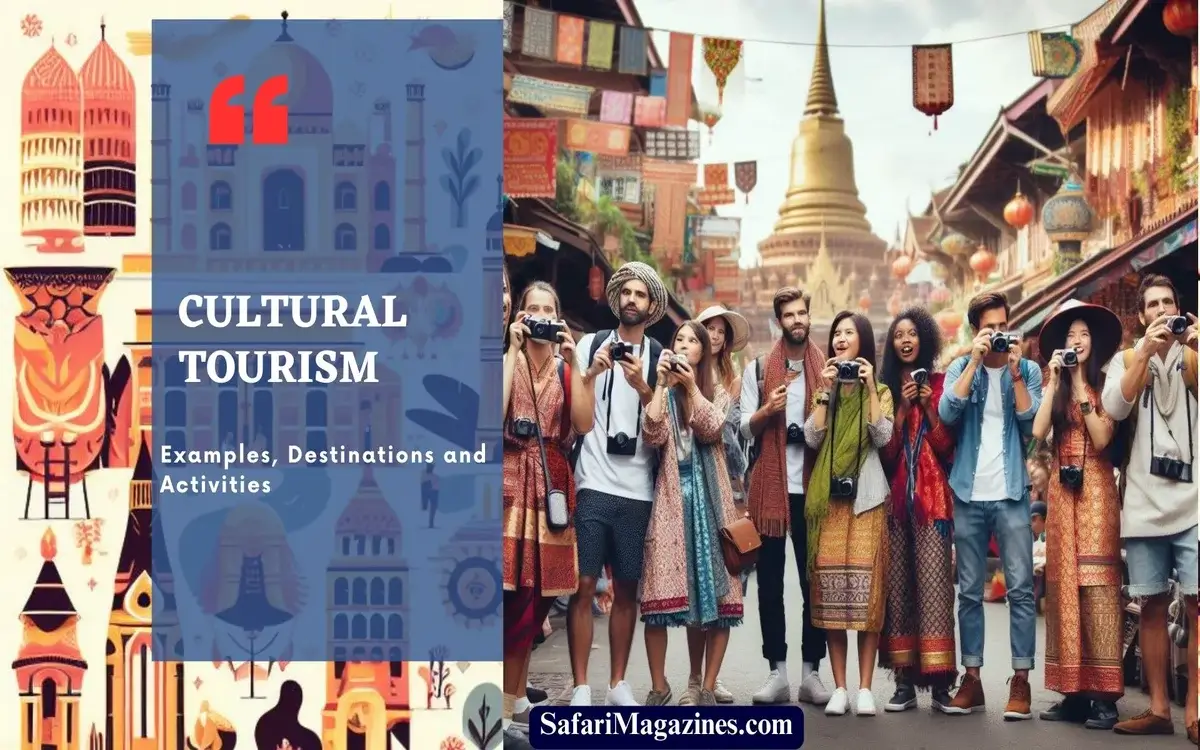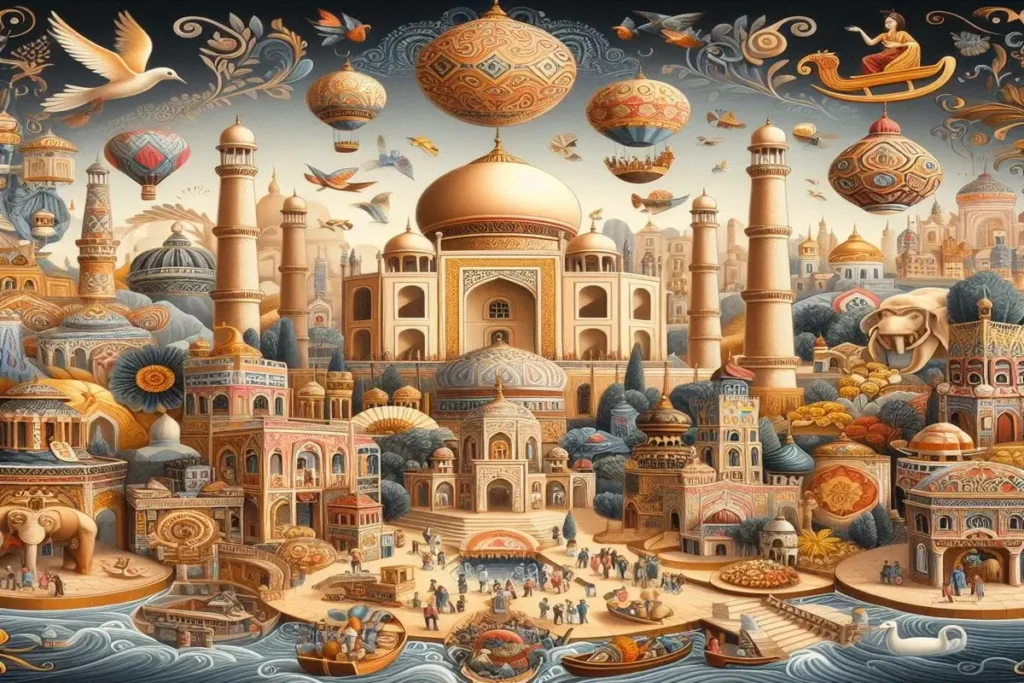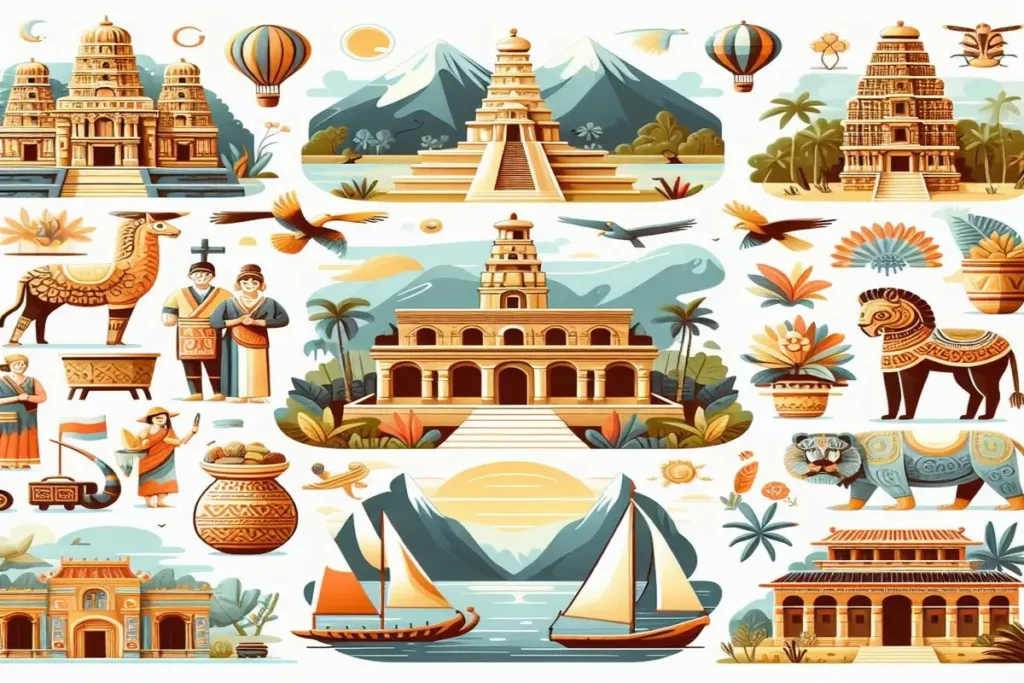
Cultural Tourism Examples, Destinations and Activities. Cultural tourism stands at the crossroads of exploration and education, giving travelers the opportunity to learn about rich heritage and traditions around the world. From ancient ruins to lively festivals, cultural tourism exemplifies the fusion of adventure and enlightenment. Let’s go on a journey through some captivating cultural tourism examples that show the diversity and allure of this phenomenon.
Table of Contents
ToggleOverview of Cultural Tourism

Cultural tourism is not limited to visiting landmarks only; it is also about to be where you are with all your senses, understanding its history, traditions and way of life. It includes activities that celebrate the cultural heritage of a visited place while promoting cross-cultural exchange and appreciation. We can say that, cultural tourism is a bridge that connects travelers to the soul of a community, leaving unforgettable imprints of shared experiences.
Benefits of Cultural Tourism
The symbiotic relationship between tourism and culture manifests in numerous ways, yielding substantial benefits for both travelers and local communities. Economically, cultural tourism injects vitality into destinations, stimulating job creation and revenue generation. Furthermore, it motivates us to preserve cultural heritage, and protect monuments, traditions and craft practices from the effects of time and neglect. Also, cultural tourism promotes mutual understanding and tolerance, breaks down barriers and develops a sense of global citizenship.
Continue reading: Cultural Tourism Examples, Destinations and Activities
Types of Cultural Tourism

Cultural tourism comes in different forms, each offers a special experience for travelers
Heritage Tourism:
Focuses on visiting historical sites, museums, and monuments to learn about the cultural heritage of a region.
Indigenous Tourism:
Involves engaging with indigenous communities to learn about their traditions, customs, and way of life.
Festival Tourism:
Centers around attending cultural festivals and events to experience local celebrations and rituals.
Religious Tourism:
It is about visiting holy sites, pilgrimage destinations and religious monuments to explore the spiritual heritage of the region.
Popular Cultural Tourism Destinations
Across the continents, there are countless destinations that attract culture lovers with their enchanting offerings.
In Europe, the romantic allure of Florence, Italy, captivates visitors with its Renaissance architecture and artistic treasures. Meanwhile, Kyoto, Japan, offers a glimpse into ancient traditions amidst serene temples and elegant tea ceremonies. In Africa, the crowded souks and labyrinthine streets of Marrakech, Morocco, evoke an atmosphere of strange magic. Likewise, the cobblestone streets of Cusco, Peru, serve as a gateway to the enigmatic wonders of the Inca Empire.
Top 20 of Popular Cultural Tourism Destinations:
Europe
- Florence, Italy: A Renaissance masterpiece with landmarks such as the Duomo and the Uffizi Gallery.
- Paris, France: The City of Light radiates cultural charm with its art, cuisine, and architectural splendor.
- Barcelona, Spain: A vibrant city where the avant-garde meets ancient history, with attractions such as Sagrada Familia and Park Güell.
- Athens, Greece: The cradle of Western civilization, offering a rich tapestry of ancient ruins and classical heritage.
- Prague, Czech Republic: A fairytale city adorned with medieval castles, cobblestone streets, and a rich musical tradition.
Asia
- Kyoto, Japan: A serene sanctuary of traditional culture, home to exquisite temples, gardens, and tea ceremonies.
- Varanasi, India: The spiritual heart of India, where ancient rituals unfold along the banks of the sacred Ganges River.
- Siem Reap, Cambodia: Gateway to the awe-inspiring temples of Angkor Wat, a UNESCO World Heritage site.
- Seoul, South Korea: A dynamic blend of ancient traditions and modern innovation, boasting vibrant markets, palaces, and street food.
- Bhaktapur, Nepal: A living museum of Newari architecture and culture, offering a glimpse into Nepal’s medieval past.
Africa
- Marrakech, Morocco: A sensory feast of vibrant souks, palaces, and mosques amidst the backdrop of the Atlas Mountains.
- Cape Town, South Africa: A melting pot of cultures, framed by stunning natural beauty and a rich history of struggle and resilience.
- Cairo, Egypt: An ancient metropolis brimming with treasures, including the pyramids of Giza, Sphinx, and Egyptian Museum.
- Zanzibar, Tanzania: A spice- scented island paradise steeped in Swahili culture, with maze-like streets and clean beaches.
- Lalibela, Ethiopia: Home to awe- inspiring rock- hewn churches dating back to the 12th century, offering a glimpse into Ethiopia’s religious heritage.
South America
- Cusco, Peru: The former capital of the Inca Empire, surrounded by archaeological wonders such as Machu Picchu and Sacred Valley.
- Rio de Janeiro, Brazil: A vibrant city pulsating with samba rhythms, iconic landmarks such as Christ the Redeemer, and breathtaking natural scenery.
- Oaxaca, Mexico: A culinary and cultural mecca renowned for its indigenous traditions, colonial architecture, and vibrant festivals.
- Cartagena, Colombia: A romantic coastal city steeped in history, with colorful colonial buildings, lively plazas, and Caribbean charm.
- Buenos Aires, Argentina: The birthplace of tango, boasting elegant boulevards, historic neighborhoods, and a thriving arts scene.
These destinations offer a diverse array of cultural experiences, each reflecting the unique heritage and traditions of its region. From ancient ruins to vibrant cities, they invite travelers to embark on a journey of discovery and enlightenment.
Continue reading: Cultural Tourism Examples, Destinations and Activities
Cultural Tourism Activities

Cultural tourism thrives on experiential immersion, offering a plethora of activities that cater to diverse interests. From heritage tours tracing the footsteps of ancestors to culinary escapades exploring local flavors and delicacies, there’s something to enthrall every palate. Festivals and events provide a vibrant showcase of tradition and creativity, while art and craft workshops offer hands-on encounters with indigenous artisans, fostering appreciation for their craftsmanship and cultural legacy.
Challenges of Cultural Tourism
However, the burgeoning popularity of cultural tourism also presents its share of challenges. Over-commercialization can lead to the commodification of culture, reducing heritage sites to mere tourist attractions devoid of their intrinsic value and meaning. Moreover, the phenomenon of cultural appropriation raises concerns about the respectful portrayal and representation of indigenous traditions. Additionally, the environmental footprint of tourism poses threats to fragile ecosystems and pristine landscapes, necessitating a balanced approach to sustainable development.
Sustainable Cultural Tourism Practices
To mitigate these challenges, stakeholders in cultural tourism are increasingly embracing sustainable practices that prioritize the well-being of communities and the environment. So, this includes active engagement with local residents, empowering them as custodians of their cultural heritage and beneficiaries of tourism revenues. Responsible tourism initiatives promote ethical conduct among travelers, encouraging respect for local customs and traditions. Furthermore, cultural sensitivity training equips tourism professionals with the knowledge and skills to facilitate meaningful cross-cultural interactions while minimizing negative impacts.
Continue reading: Cultural Tourism Examples, Destinations and Activities
Case Studies of Successful Cultural Tourism Initiatives
Several exemplary initiatives demonstrate the transformative power of cultural tourism when approached thoughtfully and sustainably. Machu Picchu, nestled amidst the Andean peaks of Peru, stands as a testament to the enduring legacy of the Inca civilization, drawing millions of visitors annually while implementing measures to preserve its fragile ecosystem. Similarly, Angkor Wat in Cambodia serves as a beacon of Khmer heritage, blending spiritual reverence with architectural grandeur. In Japan, the historic Gion District in Kyoto offers a glimpse into the timeless world of geisha culture, captivating visitors with its graceful allure.
Future Trends in Cultural Tourism

Looking ahead, the landscape of cultural tourism is poised for innovation and evolution. Technology will play an increasingly integral role, with virtual reality experiences offering immersive glimpses into distant cultures and historical epochs. Moreover, there’s a growing emphasis on authenticity, with travelers seeking genuine connections and meaningful encounters that transcend superficial tourism. As cultural tourism continues to evolve, it holds the promise of fostering greater empathy, appreciation, and interconnectedness among global citizens.
Related articles:
Cultural Exchanges: Homestays and Local Connections
Exploring the World Through Cultural Souvenirs
Beyond Borders: Exploring Educational Tourism Essentials
Conclusion
In conclusion, cultural tourism serves as a conduit for exploration, enlightenment, and cultural exchange. Through its myriad manifestations, it celebrates the richness and diversity of human heritage, fostering mutual understanding and appreciation across borders. However, its sustainability hinges upon responsible stewardship and mindful engagement, ensuring that the legacy of culture remains vibrant and enduring for generations to come.
FAQs:
Q1: What distinguishes cultural tourism from regular tourism?
A1: Cultural tourism focuses on experiencing and understanding the cultural heritage of a destination, whereas regular tourism may prioritize leisure activities without necessarily engaging with local culture.
Q2: How can travelers contribute to sustainable cultural tourism?
A2: Travelers can support sustainable cultural tourism by respecting local customs and traditions, minimizing their environmental impact, and patronizing responsible tourism initiatives that benefit local communities.
Q3: Are there any risks associated with cultural tourism?
A3: Yes, risks include over-commercialization, cultural appropriation, and environmental degradation. However, these can be mitigated through responsible and sustainable tourism practices.
Q4: What role does technology play in the future of cultural tourism?
A4: Technology offers opportunities for virtual reality experiences, digital storytelling, and interactive exhibits, enhancing the accessibility and authenticity of cultural tourism offerings.
Q5: How can communities ensure the preservation of their cultural heritage amidst increasing tourism?
A5: Communities can implement strategies such as cultural sensitivity training, sustainable development initiatives, and active involvement in tourism management to safeguard their cultural heritage while benefiting from tourism revenue.
